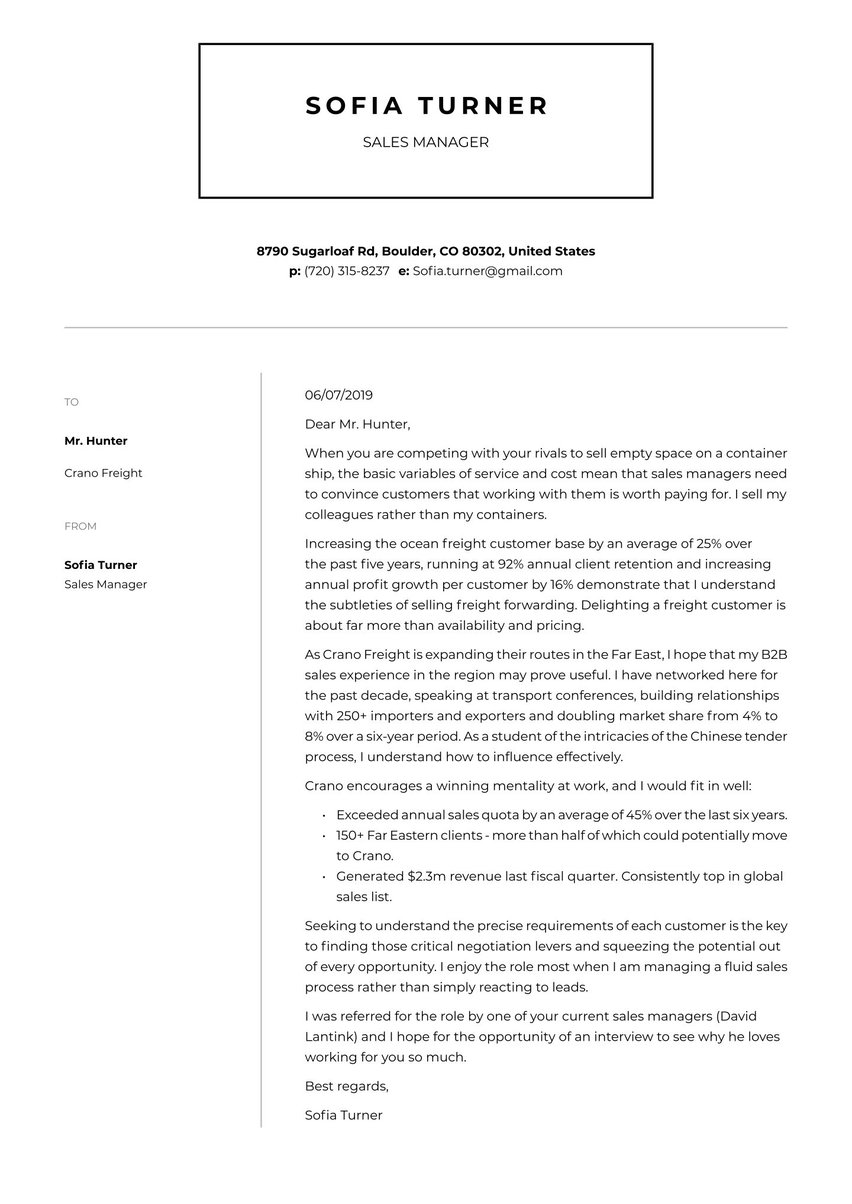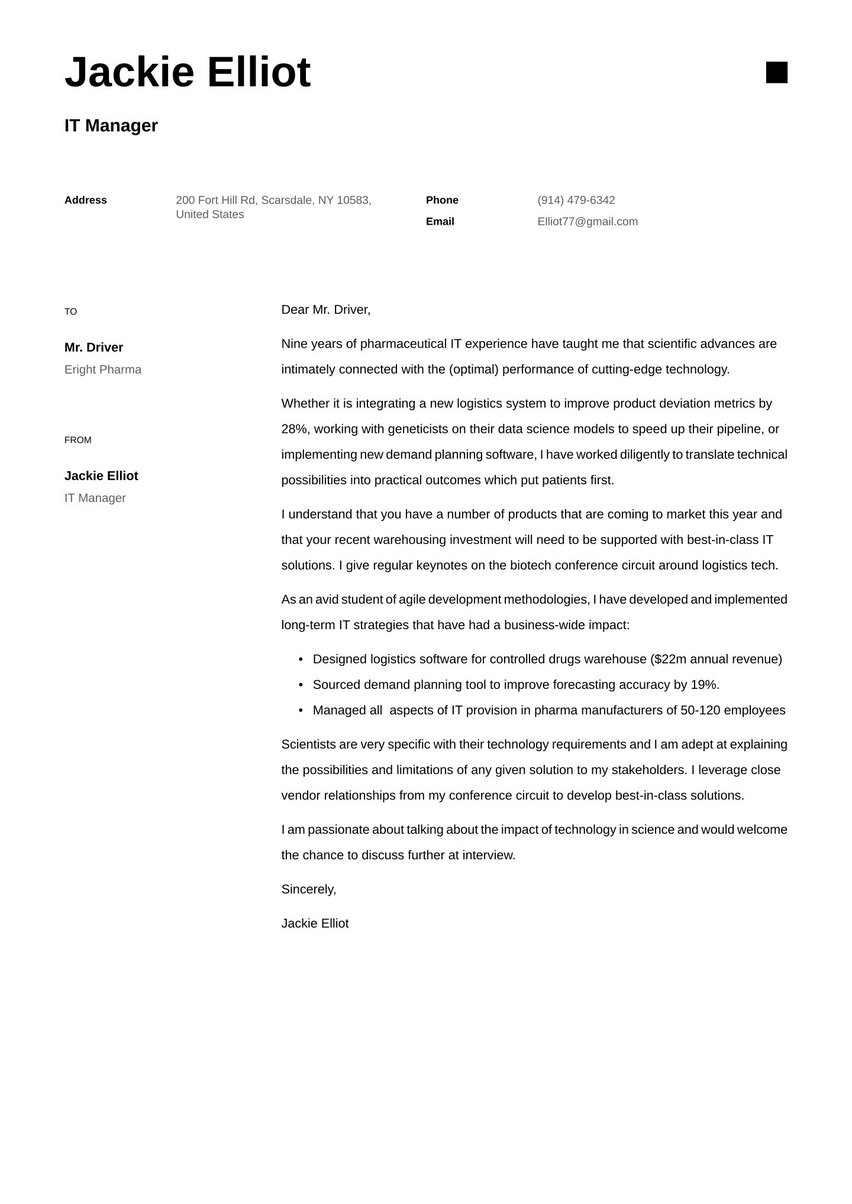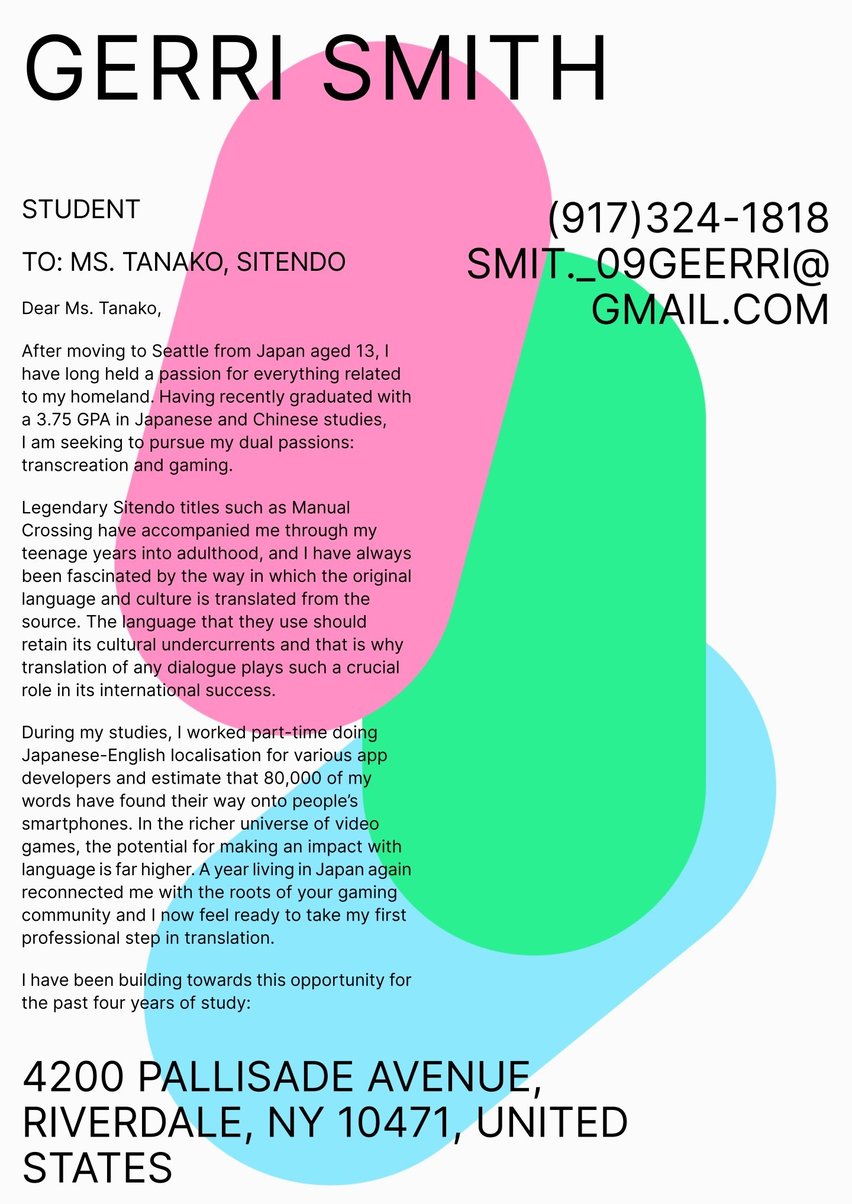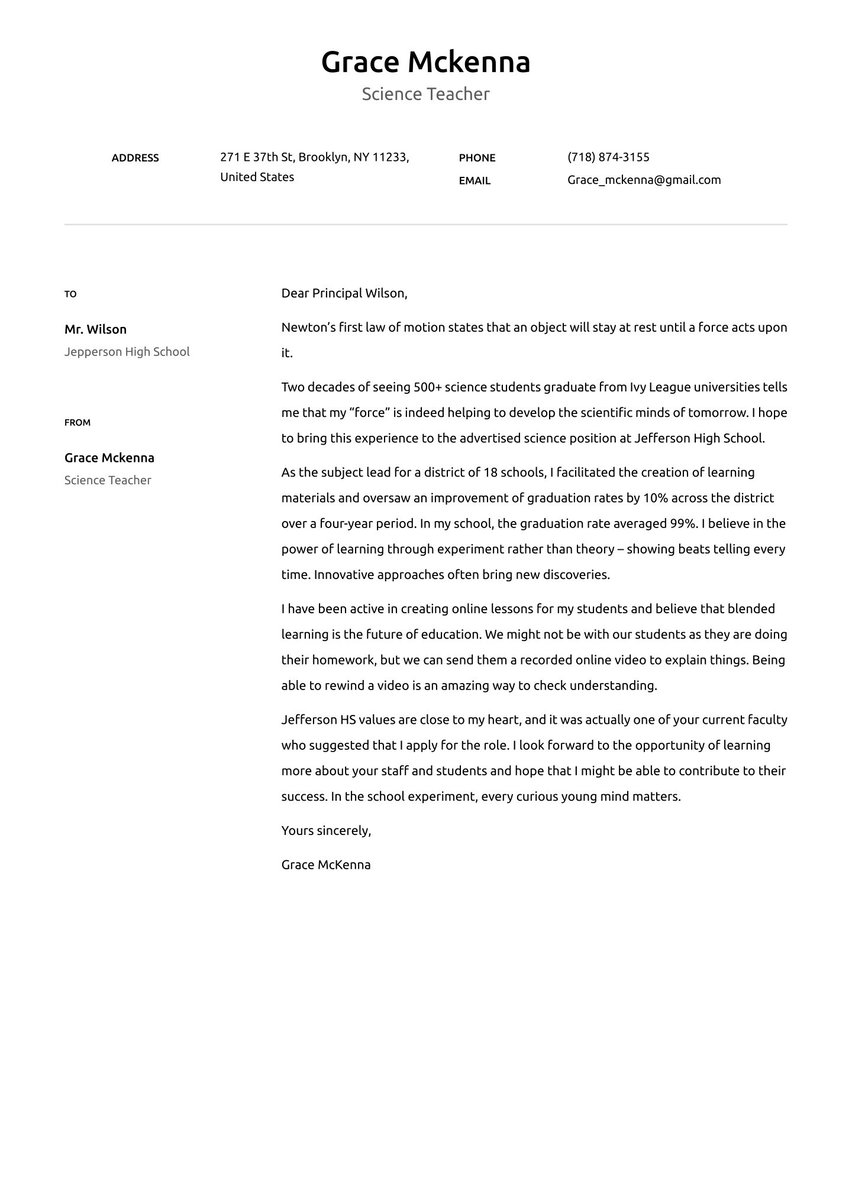From schools and hospitals to law firms and small businesses, receptionists are often the first impression companies and businesses make to their clients.
Your receptionist cover letter is the first impression you provide of yourself as a potential hire, demonstrating your skills, expertise, and the value you bring. The aim is to convince an employer that you’ve got the right mix of skills and personality to get the job done. So. make your first impression a good one!
Receptionist full text-only cover letter example
Dear Mr. Loxley,
Having worked as a part-time public relations receptionist for the past three years, I understand that every campaign starts with an emotional connection.
The moment someone enters our office, it is my duty to ensure that they are not distracted from that creative state of mind by a double-booked meeting room, misdirected call or apathetic attitude. If I can, I aim to maintain their state of flow by offering some pleasant politics-free chat or giving them an honest opinion on the latest promotional idea.
My job is to help keep their ideas flowing by providing professional and efficient assistance however I am able. I type at 90 wpm, am used to routing 250+ calls a day, and greet up to 80 daily visitors with a warm and accessible attitude.
At the reception desk, you never quite know what might be asked of you. But in light of my career goal to enter the PR profession after my studies, I go the extra mile whenever possible:
- Organized accommodation and travel for 60 press trips (40+ journalists each time)
- Collate daily press clippings from 35 news outlets, as required to prepare client presentations.
- Maintain editorial, conference and press calendars and updating database.
- Coordinate employee input for social media platforms and tracking engagement.
The people who walk into my reception area (or who call on the phone) are my absolute priority for as long as they need me, but I believe that a PR receptionist can offer more.
I have long followed Imagazine PR’s success on social media and I would love the opportunity for an interview to see whether we have that special connection. I sense that we might.
Sincerely,
Theresa Bennet
Sections of a receptionist cover letter
Some people dread the cover letter writing process because they don’t know how to structure it. Luckily, we’ve got the secret. In this section, we break down the most common parts of a cover letter into easy-to-follow steps to save you time and frustration. at
The format of your receptionist cover letter should include these key components:
- Cover letter header. Provide your contact information and the date. It’s like introducing yourself to a new client or company visitor.
- Greeting. This is the written equivalent of a friendly smile. Address the hiring manager by name—it gives your letter a personal touch and shows that this isn’t a “generic” cover letter.
- Introduction. This is your chance to grab the reader’s attention with a brief introduction, telling them who you are and why you’re excited about the position.
- Body. This is the heart of your cover letter. Give a concise overview of your relevant skills, achievements, and experience. This is a great place to add a little “pizzazz” to your letter by demonstrating why you’re the person they need to have behind the receptionist’s desk, how you can solve the company’s needs, and how you align with their values.
- Conclusion. End on a strong note by providing a summary of your qualifications, underscoring your interest in the role, and encouraging the reader to take the next steps with a call to action.
- Signature. Use a professional sign-off, such as "Sincerely" or “Yours truly,” and include your first and last name.
Don’t feel like you can just “wing it” or skip one of the above sections. Each section of your cover letter is a key aspect of your professional journey, why you’re good at your job, and what makes you special.
This is not a place for your life story, however. You should create a one-page cover letter that gives an overview of your skills and experience; one that creates a narrative about your professional journey.
It’s more than “just a formality;” it’s your first chance to show a potential employer why you should be the face of their organization and how your skills, values, and experience align with theirs.
If you’re looking for more help and inspiration, check out other relevant cover letter examples from the receptionist realm:
If you need more help or want to go into more detail on each section, view our article on how to write a cover letter.
Once you’ve provided your header and addressed the hiring manager, the next step is your introduction.
Introduction of a receptionist cover letter
When starting a cover letter for a receptionist position, grab the reader’s attention by highlighting one of your best, most relevant achievements.
This is what is going to motivate the hiring manager to keep reading. Perhaps you implemented a new scheduling system to reduce appointment wait times, or streamlined administrative tasks to improve efficiency.
Dear Ms. Thompson,
I am writing to express my strong interest in the Receptionist position at Sunshine Manufacturing. With my outstanding organizational skills, positive, outgoing demeanor, and commitment to providing top-notch client service, I am confident that I would be a valuable addition to your administrative team.
Hello, my name is Mary, and I am interested in the receptionist position at Sunshine Manufacturing. I have three years of experience and I think I’d be good at the job.
Don’t waste valuable space on a boring introduction. Create a compelling example that demonstrates how you use your skills on the job. For example, if you overhauled the appointment system, resulting in a '15% increase in client satisfaction rates,' mention this achievement near the beginning. Providing quantifiable data to support your achievements shows the hiring manager that you get results.
Remember, though, you’re not just listing your accomplishments; you’re demonstrating how you can meet the company’s needs. It shows them that you’re an achiever, not just just someone who sits at a desk.
Dear Mr. Loxley,
Having worked as a part-time public relations receptionist for the past three years, I understand that every campaign starts with an emotional connection.
Receptionist cover letter body
The body of your cover letter should follow a clear road map:
- Underscore your background, skills, and work experience.
- Demonstrate why you’d be a great addition to the team. Companies want to hire people they know will “fit in.”
- Conclude your letter in a way that excites the hiring manager about your skills.
- Close with a strong call to action that motivates the hiring manager to take the next steps in the hiring process.
First body paragraph: your suitability for the role (skills & experience)
Here, you’ll talk about your previous successes and milestones, and how your unique perspective and skillset brought you to those places.
In each example, the STAR acronym is useful to remember this method for laying out: the situation, the task, your action and the positive result it brought.
Here’s how you can incorporate your skills and expertise into an an effective narrative:
- Place a spotlight on your customer experience skills. Give a vibrant, compelling overview of how you’ve used your extensive skills on the job to support the client experience.
- Organization and communication. Provide examples of how your organizational skills benefited your previous employer, and how you act as a communication “hub” for the company.
- Technology and computer skills. Demonstrate how you use technology to increase efficiency and client support—like software, task platforms, or phone systems. If you regularly take classes to keep your skills current, mention it. It demonstrates your commitment to professional development.
- Problem solving. Show how you’ve used your skills to fix issues that have arisen on the job as well as the positive outcomes of your efforts.
The power of “liking”
As a receptionist, you’re qualified to work in a variety of industries and companies, as the skills are usually transferable. Your cover letter is a great opportunity, however, to stand out to a company xplaining your personal motivations to work in a particular company or industry. For example, maybe you’ve always been attracted to a music media company because you’re a lifelong pianist. Or perhaps your experience in two previous medical-related positions have given you a great appreciation for the pharmaceutical industry. This is referred to as the Power of Liking, meaning we are more likely to connect with people with whom we share commonalities.
Second body paragraph(s): alignment with the organization
You shouldn’t write the exact same letter for each job you apply for; tailor it to industry, culture, and overall tone of each company. Do your homework and find the things that stand out to you about a company, and align your cover letter accordingly.
Let’s say you’re applying for the receptionist position at the headquarters of The Humane Society. Some important points that can be found on the Mission Statement page of their website include:
- End the cruelest practices toward all animals.
- Care for animals in crisis.
- Build a stronger animal protection movement.
Weave aspects of this organization’s mission statement into your cover letter, and if you have a personal story, like fond memories of adopting a beloved pet, include that, too, as this will demonstrate a sincere interest in their work and an alignment with their stated goals and values.
The moment someone enters our office, it is my duty to ensure that they are not distracted from that creative state of mind by a double-booked meeting room, misdirected call or apathetic attitude. If I can, I aim to maintain their state of flow by offering some pleasant politics-free chat or giving them an honest opinion on the latest promotional idea.
My job is to help keep their ideas flowing by providing professional and efficient assistance however I am able. I type at 90 wpm, am used to routing 250+ calls a day, and greet up to 80 daily visitors with a warm and accessible attitude.
At the reception desk, you never quite know what might be asked of you. But in light of my career goal to enter the PR profession after my studies, I go the extra mile whenever possible:
- Organized accommodation and travel for 60 press trips (40+ journalists each time)
- Collate daily press clippings from 35 news outlets, as required to prepare client presentations.
- Maintain editorial, conference and press calendars and updating database.
- Coordinate employee input for social media platforms and tracking engagement.
The people who walk into my reception area (or who call on the phone) are my absolute priority for as long as they need me, but I believe that a PR receptionist can offer more.
Call to action & conclusion: end on a strong note
Wrap up your cover letter by restating your main points and expressing your excitement for the receptionist opportunity.
Add an encouraging call to action to motivate the hiring manager to contact you to discuss how your goals and experience are compatible with those of the company.
Always convey gratitude to the hiring manager for their time and attention. It’s good manners, true, but it’s another opportunity to express your enthusiasm for the position.
Conclude your letter with confidence and provide an unambiguous invitation for the hiring manager to take the next step in the hiring process. Don’t be shy: ask for what you want!
I have long followed Imagazine PR’s success on social media and I would love the opportunity for an interview to see whether we have that special connection. I sense that we might.
Sincerely,
Theresa Bennet
After the call to action, conclude your letter by signing off with your name. While this is standard practice in business communication, it’s also a nice, personal touch that also demonstrates your professionalism and attention to detail.
How to write a receptionist cover letter with no experience
If you’re applying for a receptionist position but don't have any professional work experience, don’t despair.
You can still write a compelling cover letter that includes work you did as a student, volunteer work, or a summer job. The important thing is to emphasize your transferable skills and enthusiasm for both the job and the industry it's in.
How do you do that?
- Highlight transferable skills by showing how skills you developed during your student years can be useful in a receptionist role. Maybe you have strong organizational skills. Highlight how these skills helped you develop your teamwork and critical thinking skills, both of which are important for receptionists to work with others and solve problems that arise daily.
- Showcase time management abilities. If you have experience juggling a lot of projects, relate it to the receptionist role and how you would manage your workload.
- Show off your tech skills. Receptionists use a variety of technology, such as word processing, project management platforms, spreadsheets, and calendar management. Demonstrate how you’ve used different tech applications in previous roles to show computer literacy and commitment to professional growth.
- Demonstrate that you’re a “people person”. Receptionists have to be able to effectively interact and communicate with a variety of people. Show how you’ve been able to do this in previous roles such as volunteer work, student organizations, or internships.
- Include relevant volunteer work. Even if it's unpaid, it still counts. Not only does it show that you care about the world around you, but it can also show off the skills you have developed while helping others. Include any volunteering you've done at events, schools, or community centers to highlight your community involvement.
Including these things will help make up for the lack of direct experience in your cover letter and show how you would function as an employee, no matter how many years of experience you have.
Optimize for the ATS
Many companies, especially larger ones, use some form of an Applicant Tracking System (ATS), which is an automated system for ranking and sorting job applications.
The ATS algorithm does this by sorting through resumes and applications by scanning for specific keywords that were designated by the hiring manager as desirable skills and traits.
To identify important keywords, examine the receptionist job description and identify words that are used frequently or in the list of qualifications. If you have those skills, incorporate them into your cover letter. Don’t go overboard, though. Remember that it will (hopefully) be read by a human at some point, and overusing the keywords will sound awkward or unnatural.
Example:
- “Experience with scheduling software”
- “Five years of experience”
- “Organized, friendly, and outgoing”
Key takeaways
A great receptionist cover letter can help convince an employer that you’ve got the right mix of skills and personality to get the job done.
Throughout your receptionist cover letter, from the introduction to the conclusion, highlight your unique strengths and commitment to the role. If you’re changing careers or are a fresh graduate, emphasize your transferable skills and willingness to develop new skills.
Begin your job search with our cover letter generator and online resume builder, and then elevate it with resume.io.
With 18 career-boosting tools, you can easily search for receptionist jobs, track your progress, prepare for interviews, and negotiate salaries with confidence using our complete career toolkit.




























